Attached files
| file | filename |
|---|---|
| EX-99.1 - EX-99.1 - HOST HOTELS & RESORTS, INC. | hst-ex991_7.htm |
| 8-K - 8-K - HOST HOTELS & RESORTS, INC. | hst-8k_20210218.htm |
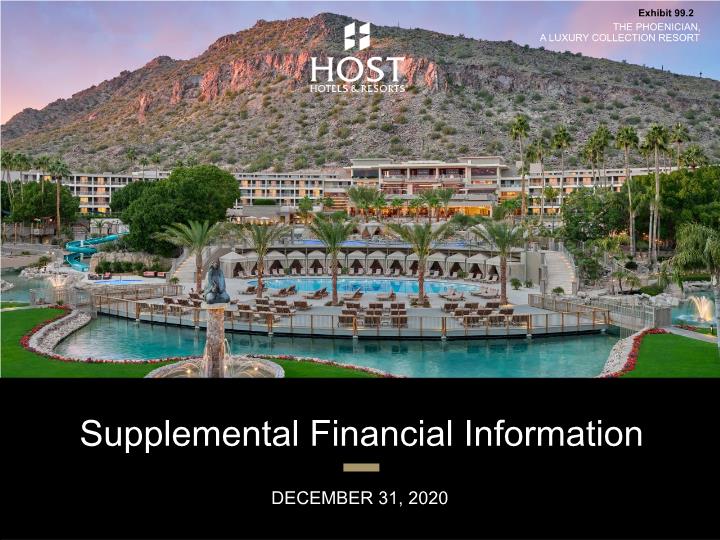
Supplemental Financial Information DECEMBER 31, 2020 Exhibit 99.2
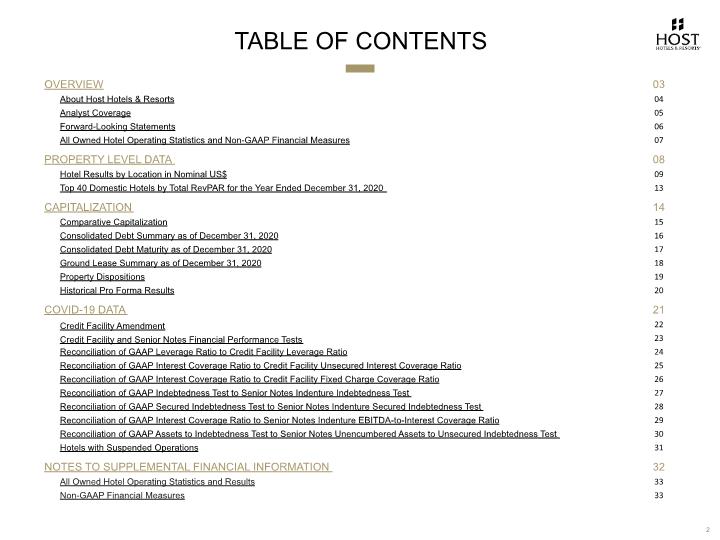
Table of Contents 2
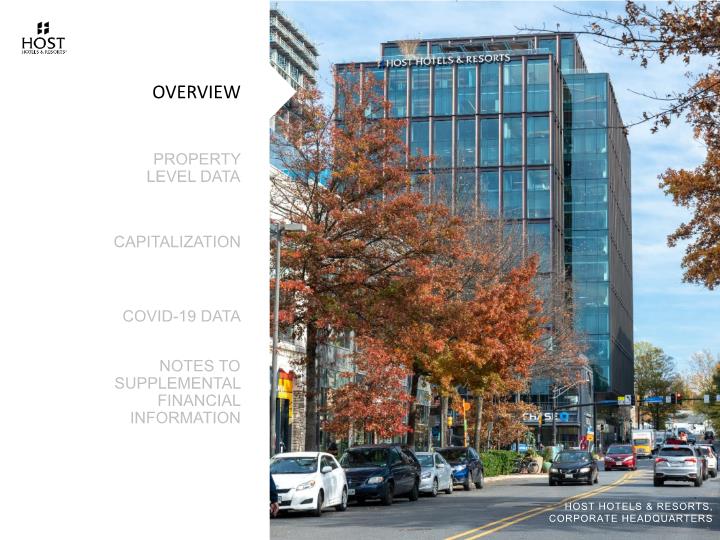
OVERVIEW PROPERTY LEVEL DATA CAPITALIZATION COVID-19 DATA NOTES TO SUPPLEMENTAL FINANCIAL INFORMATION 3
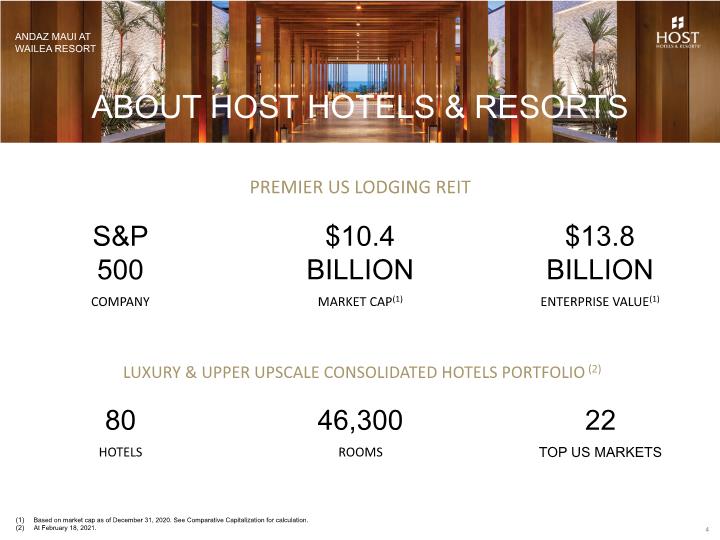
About host Hotels & Resorts 4 Premier US LODGING REIT LUXURY & UPPER UPSCALE CONSOLIDATED HOTELS PORTFOLIO(2) Based on market cap as of December 31, 2020. See Comparative Capitalization for calculation. At February 18, 2021.

5 Analyst Coverage The Company is followed by the analysts listed above. Please note that any opinions, estimates or forecasts regarding the Company’s performance made by these analysts are theirs alone and do not represent opinions, forecasts or predictions of the Company or its management. The Company does not by its reference above imply its endorsement of or concurrence with any of such analysts’ information, conclusions or recommendations.
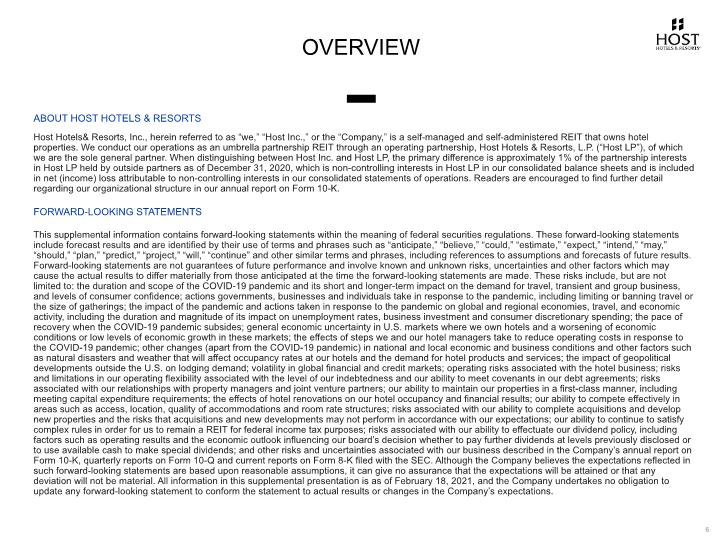
ABOUT HOST HOTELS & RESORTS Host Hotels& Resorts, Inc., herein referred to as “we,” “Host Inc.,” or the “Company,” is a self-managed and self-administered REIT that owns hotel properties. We conduct our operations as an umbrella partnership REIT through an operating partnership, Host Hotels & Resorts, L.P. (“Host LP”), of which we are the sole general partner. When distinguishing between Host Inc. and Host LP, the primary difference is approximately 1% of the partnership interests in Host LP held by outside partners as of December 31, 2020, which is non-controlling interests in Host LP in our consolidated balance sheets and is included in net (income) loss attributable to non-controlling interests in our consolidated statements of operations. Readers are encouraged to find further detail regarding our organizational structure in our annual report on Form 10-K. Forward-Looking Statements This supplemental information contains forward-looking statements within the meaning of federal securities regulations. These forward-looking statements include forecast results and are identified by their use of terms and phrases such as “anticipate,” “believe,” “could,” “estimate,” “expect,” “intend,” “may,” “should,” “plan,” “predict,” “project,” “will,” “continue” and other similar terms and phrases, including references to assumptions and forecasts of future results. Forward-looking statements are not guarantees of future performance and involve known and unknown risks, uncertainties and other factors which may cause the actual results to differ materially from those anticipated at the time the forward-looking statements are made. These risks include, but are not limited to: the duration and scope of the COVID-19 pandemic and its short and longer-term impact on the demand for travel, transient and group business, and levels of consumer confidence; actions governments, businesses and individuals take in response to the pandemic, including limiting or banning travel or the size of gatherings; the impact of the pandemic and actions taken in response to the pandemic on global and regional economies, travel, and economic activity, including the duration and magnitude of its impact on unemployment rates, business investment and consumer discretionary spending; the pace of recovery when the COVID-19 pandemic subsides; general economic uncertainty in U.S. markets where we own hotels and a worsening of economic conditions or low levels of economic growth in these markets; the effects of steps we and our hotel managers take to reduce operating costs in response to the COVID-19 pandemic; other changes (apart from the COVID-19 pandemic) in national and local economic and business conditions and other factors such as natural disasters and weather that will affect occupancy rates at our hotels and the demand for hotel products and services; the impact of geopolitical developments outside the U.S. on lodging demand; volatility in global financial and credit markets; operating risks associated with the hotel business; risks and limitations in our operating flexibility associated with the level of our indebtedness and our ability to meet covenants in our debt agreements; risks associated with our relationships with property managers and joint venture partners; our ability to maintain our properties in a first-class manner, including meeting capital expenditure requirements; the effects of hotel renovations on our hotel occupancy and financial results; our ability to compete effectively in areas such as access, location, quality of accommodations and room rate structures; risks associated with our ability to complete acquisitions and develop new properties and the risks that acquisitions and new developments may not perform in accordance with our expectations; our ability to continue to satisfy complex rules in order for us to remain a REIT for federal income tax purposes; risks associated with our ability to effectuate our dividend policy, including factors such as operating results and the economic outlook influencing our board’s decision whether to pay further dividends at levels previously disclosed or to use available cash to make special dividends; and other risks and uncertainties associated with our business described in the Company’s annual report on Form 10-K, quarterly reports on Form 10-Q and current reports on Form 8-K filed with the SEC. Although the Company believes the expectations reflected in such forward-looking statements are based upon reasonable assumptions, it can give no assurance that the expectations will be attained or that any deviation will not be material. All information in this supplemental presentation is as of February 18, 2021, and the Company undertakes no obligation to update any forward-looking statement to conform the statement to actual results or changes in the Company’s expectations. 6 overview
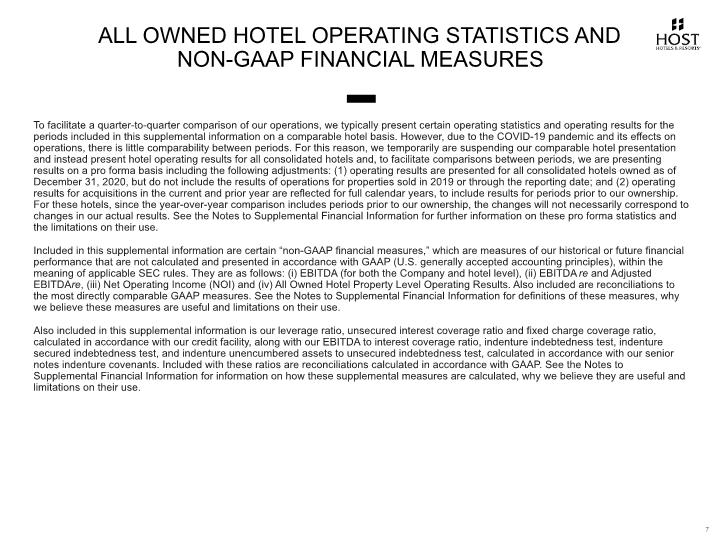
To facilitate a quarter-to-quarter comparison of our operations, we typically present certain operating statistics and operating results for the periods included in this supplemental information on a comparable hotel basis. However, due to the COVID-19 pandemic and its effects on operations, there is little comparability between periods. For this reason, we temporarily are suspending our comparable hotel presentation and instead present hotel operating results for all consolidated hotels and, to facilitate comparisons between periods, we are presenting results on a pro forma basis including the following adjustments: (1) operating results are presented for all consolidated hotels owned as of December 31, 2020, but do not include the results of operations for properties sold in 2019 or through the reporting date; and (2) operating results for acquisitions in the current and prior year are reflected for full calendar years, to include results for periods prior to our ownership. For these hotels, since the year-over-year comparison includes periods prior to our ownership, the changes will not necessarily correspond to changes in our actual results. See the Notes to Supplemental Financial Information for further information on these pro forma statistics and the limitations on their use. Included in this supplemental information are certain “non-GAAP financial measures,” which are measures of our historical or future financial performance that are not calculated and presented in accordance with GAAP (U.S. generally accepted accounting principles), within the meaning of applicable SEC rules. They are as follows: (i) EBITDA (for both the Company and hotel level), (ii) EBITDAre and Adjusted EBITDAre, (iii) Net Operating Income (NOI) and (iv) All Owned Hotel Property Level Operating Results. Also included are reconciliations to the most directly comparable GAAP measures. See the Notes to Supplemental Financial Information for definitions of these measures, why we believe these measures are useful and limitations on their use. Also included in this supplemental information is our leverage ratio, unsecured interest coverage ratio and fixed charge coverage ratio, calculated in accordance with our credit facility, along with our EBITDA to interest coverage ratio, indenture indebtedness test, indenture secured indebtedness test, and indenture unencumbered assets to unsecured indebtedness test, calculated in accordance with our senior notes indenture covenants. Included with these ratios are reconciliations calculated in accordance with GAAP. See the Notes to Supplemental Financial Information for information on how these supplemental measures are calculated, why we believe they are useful and limitations on their use. 7 All Owned Hotel Operating Statistics and Non-GAAP Financial Measures
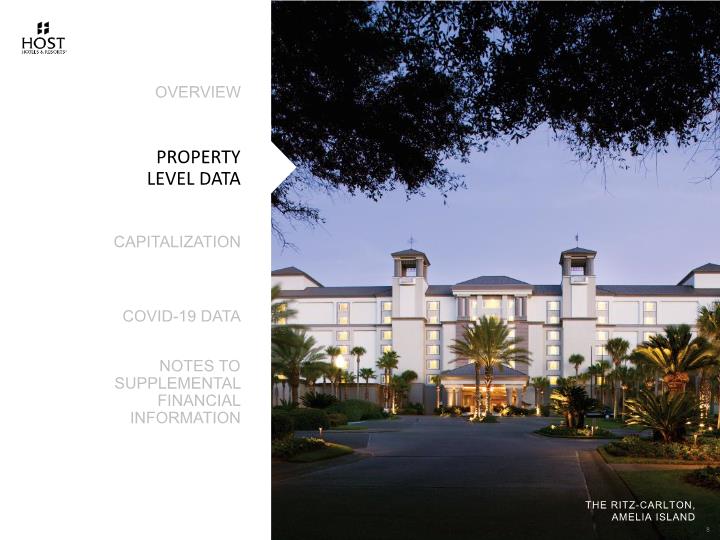
Overview Property level data capitalization Covid-19 data NOTES TO SUPPLEMENTAL FINANCIAL INFORMATION 8
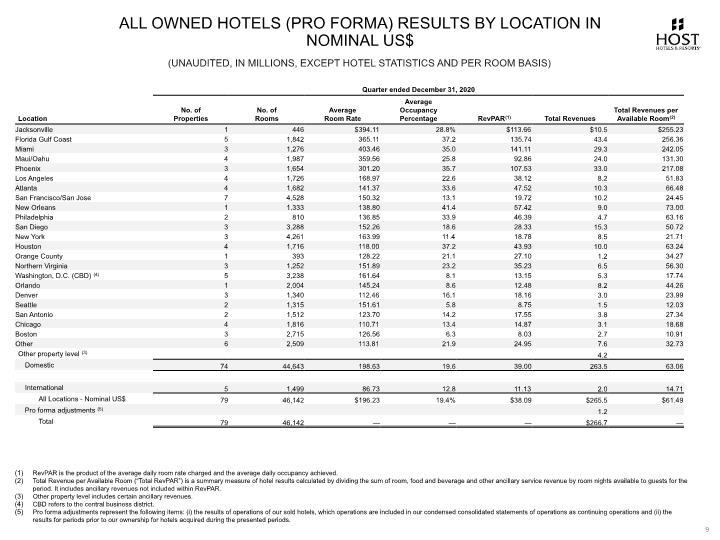
All owned Hotels (pro forma) Results by Location in Nominal US$ (unaudited, in millions, except hotel statistics and per room basis) RevPAR is the product of the average daily room rate charged and the average daily occupancy achieved. Total Revenue per Available Room (“Total RevPAR”) is a summary measure of hotel results calculated by dividing the sum of room, food and beverage and other ancillary service revenue by room nights available to guests for the period. It includes ancillary revenues not included within RevPAR. Other property level includes certain ancillary revenues. CBD refers to the central business district. Pro forma adjustments represent the following items: (i) the results of operations of our sold hotels, which operations are included in our condensed consolidated statements of operations as continuing operations and (ii) the results for periods prior to our ownership for hotels acquired during the presented periods. 9

All owned Hotels (pro forma) results by Location in Nominal US$ 10 (unaudited, in millions, except hotel statistics and per room basis) Other property level includes certain ancillary revenues. Pro forma adjustments represent the following items: (i) the results of operations of our sold hotels, which operations are included in our condensed consolidated statements of operations as continuing operations and (ii) the results for periods prior to our ownership for hotels acquired during the presented periods.

All owned Hotels (pro forma) Results by Location in Nominal US$ 11 (unaudited, in millions, except hotel statistics and per room basis) Other property level includes certain ancillary revenues. Pro forma adjustments represent the following items: (i) the results of operations of our sold hotels, which operations are included in our condensed consolidated statements of operations as continuing operations and (ii) the results for periods prior to our ownership for hotels acquired during the presented periods.
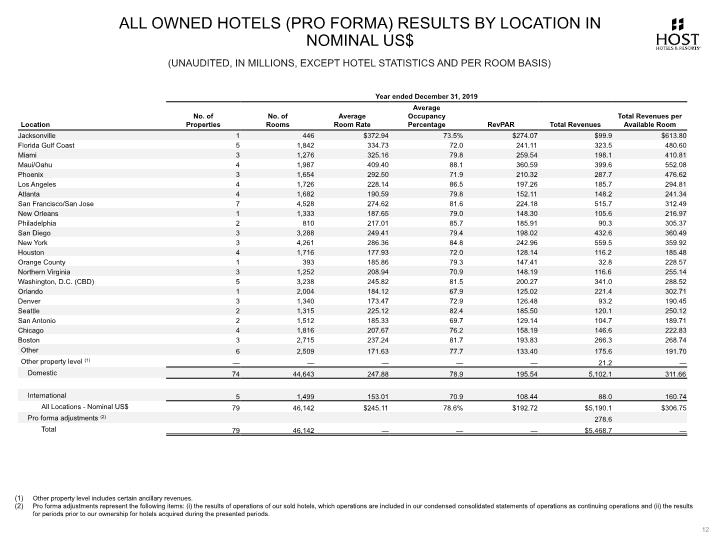
All owned Hotels (pro forma) Results by Location in Nominal US$ 12 (unaudited, in millions, except hotel statistics and per room basis) Other property level includes certain ancillary revenues. Pro forma adjustments represent the following items: (i) the results of operations of our sold hotels, which operations are included in our condensed consolidated statements of operations as continuing operations and (ii) the results for periods prior to our ownership for hotels acquired during the presented periods.

Top 40 Domestic Hotels by Total RevPAR For the Year ended December 31, 2020 13 (unaudited, in millions, except hotel statistics and per room basis) Other property level includes certain ancillary revenues.

Overview Property level data Capitalization COVID-19 Data NOTES TO SUPPLEMENTAL FINANCIAL INFORMATION 14
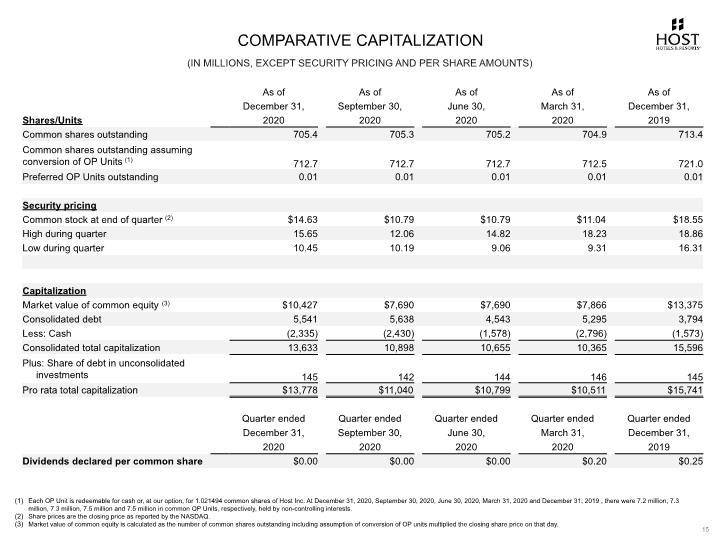
Comparative Capitalization (in millions, except security pricing and per share amounts) 15 Each OP Unit is redeemable for cash or, at our option, for 1.021494 common shares of Host Inc. At December 31, 2020, September 30, 2020, June 30, 2020, March 31, 2020 and December 31, 2019 , there were 7.2 million, 7.3 million, 7.3 million, 7.5 million and 7.5 million in common OP Units, respectively, held by non-controlling interests. Share prices are the closing price as reported by the NASDAQ. Market value of common equity is calculated as the number of common shares outstanding including assumption of conversion of OP units multiplied the closing share price on that day.

Consolidated Debt Summary 16 (in millions) The interest rate shown is the rate of the outstanding credit facility revolver borrowings at December 31, 2020, based on LIBOR plus 150 basis points. Depending on Host L.P.’s unsecured long-term debt rating, interest on revolver borrowings is equal to LIBOR plus a margin ranging from 117.5 to 185 basis points. There were no outstanding credit facility borrowings at December 31, 2019; the amount shown represents deferred financing costs related to the credit facility revolver. In accordance with GAAP, total debt includes the debt of entities that we consolidate, but of which we do not own 100%, and excludes the debt of entities that we do not consolidate, but of which we have a non-controlling ownership interest and record our investment therein under the equity method of accounting. As of December 31, 2020, our share of debt in unconsolidated investments is $145 million and none of our debt is attributable to non-controlling interests. Total debt as of December 31, 2020 and December 31, 2019 includes net discounts and deferred financing costs of $47 million and $35 million, respectively.
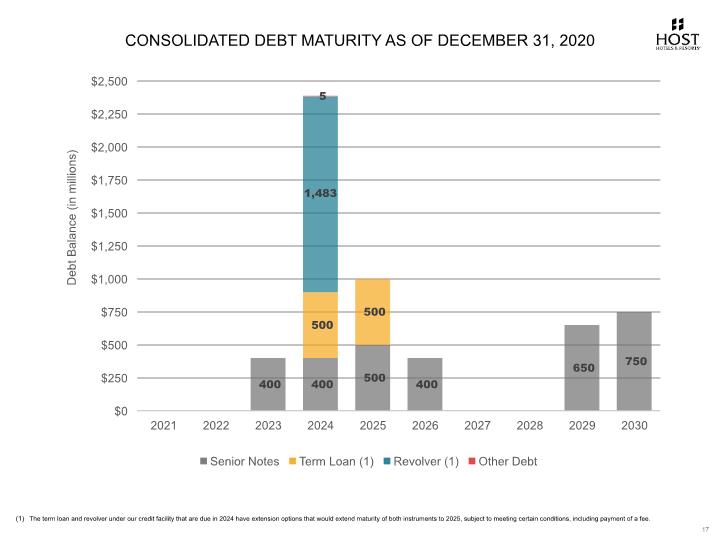
Consolidated Debt Maturity as of December 31, 2020 17 The term loan and revolver under our credit facility that are due in 2024 have extension options that would extend maturity of both instruments to 2025, subject to meeting certain conditions, including payment of a fee.
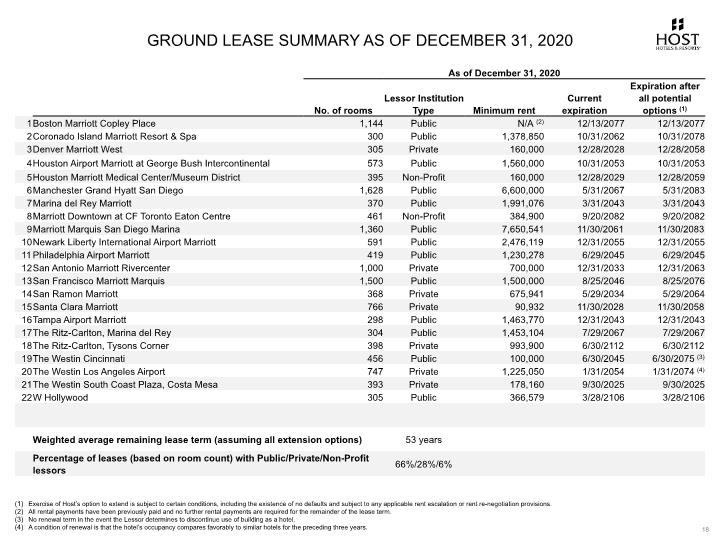
Ground Lease Summary as of December 31, 2020 18 Exercise of Host’s option to extend is subject to certain conditions, including the existence of no defaults and subject to any applicable rent escalation or rent re-negotiation provisions. All rental payments have been previously paid and no further rental payments are required for the remainder of the lease term. No renewal term in the event the Lessor determines to discontinue use of building as a hotel. A condition of renewal is that the hotel’s occupancy compares favorably to similar hotels for the preceding three years.
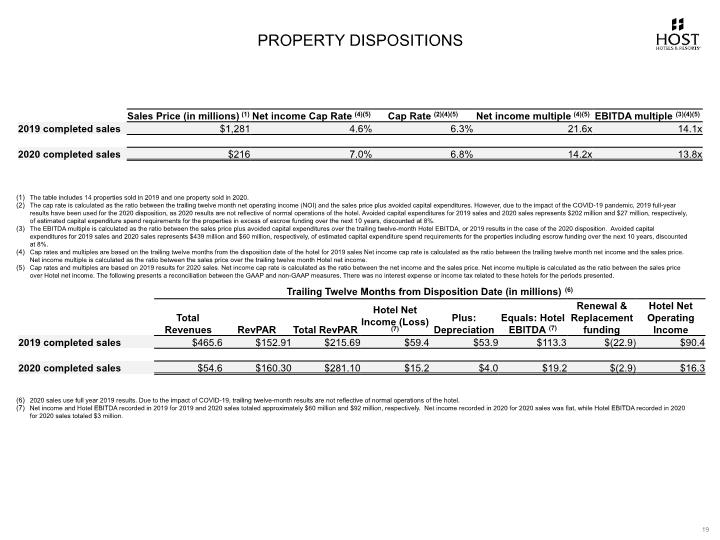
Property Dispositions 19 The table includes 14 properties sold in 2019 and one property sold in 2020. The cap rate is calculated as the ratio between the trailing twelve month net operating income (NOI) and the sales price plus avoided capital expenditures. However, due to the impact of the COVID-19 pandemic, 2019 full-year results have been used for the 2020 disposition, as 2020 results are not reflective of normal operations of the hotel. Avoided capital expenditures for 2019 sales and 2020 sales represents $202 million and $27 million, respectively, of estimated capital expenditure spend requirements for the properties in excess of escrow funding over the next 10 years, discounted at 8%. The EBITDA multiple is calculated as the ratio between the sales price plus avoided capital expenditures over the trailing twelve-month Hotel EBITDA, or 2019 results in the case of the 2020 disposition. Avoided capital expenditures for 2019 sales and 2020 sales represents $439 million and $60 million, respectively, of estimated capital expenditure spend requirements for the properties including escrow funding over the next 10 years, discounted at 8%. Cap rates and multiples are based on the trailing twelve months from the disposition date of the hotel for 2019 sales Net income cap rate is calculated as the ratio between the trailing twelve month net income and the sales price. Net income multiple is calculated as the ratio between the sales price over the trailing twelve month Hotel net income. Cap rates and multiples are based on 2019 results for 2020 sales. Net income cap rate is calculated as the ratio between the net income and the sales price. Net income multiple is calculated as the ratio between the sales price over Hotel net income. The following presents a reconciliation between the GAAP and non-GAAP measures. There was no interest expense or income tax related to these hotels for the periods presented. 2020 sales use full year 2019 results. Due to the impact of COVID-19, trailing twelve-month results are not reflective of normal operations of the hotel. Net income and Hotel EBITDA recorded in 2019 for 2019 and 2020 sales totaled approximately $60 million and $92 million, respectively. Net income recorded in 2020 for 2020 sales was flat, while Hotel EBITDA recorded in 2020 for 2020 sales totaled $3 million.
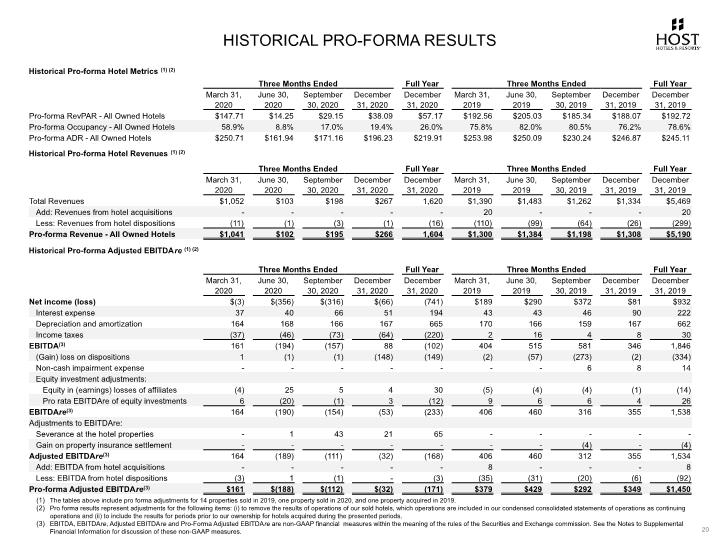
HISTORICAL PRO-FORMA RESULTS 20 Historical Pro-forma Hotel Metrics (1) (2) Historical Pro-forma Hotel Revenues (1) (2) Historical Pro-forma Adjusted EBITDAre (1) (2) The tables above include pro forma adjustments for 14 properties sold in 2019, one property sold in 2020, and one property acquired in 2019. Pro forma results represent adjustments for the following items: (i) to remove the results of operations of our sold hotels, which operations are included in our condensed consolidated statements of operations as continuing operations and (ii) to include the results for periods prior to our ownership for hotels acquired during the presented periods. EBITDA, EBITDAre, Adjusted EBITDAre and Pro-Forma Adjusted EBITDAre are non-GAAP financial measures within the meaning of the rules of the Securities and Exchange commission. See the Notes to Supplemental Financial Information for discussion of these non-GAAP measures.
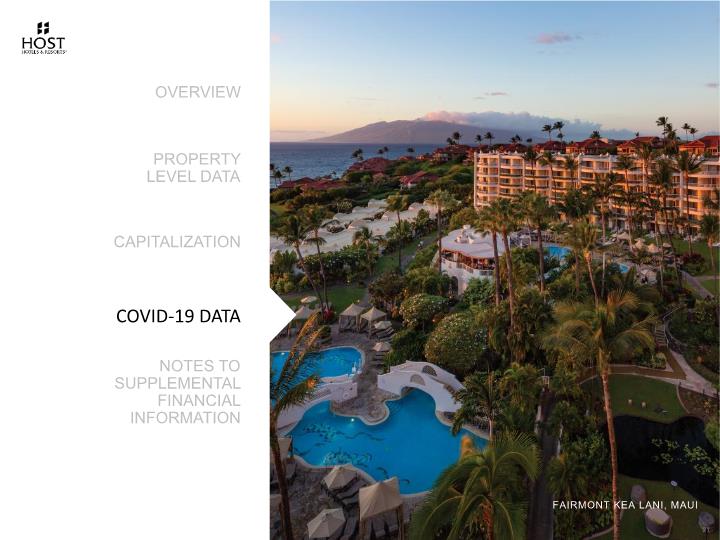
Overview Property Level Data Capitalization COVID-19 Data NOTES TO SUPPLEMENTAL FINANCIAL INFORMATION 21
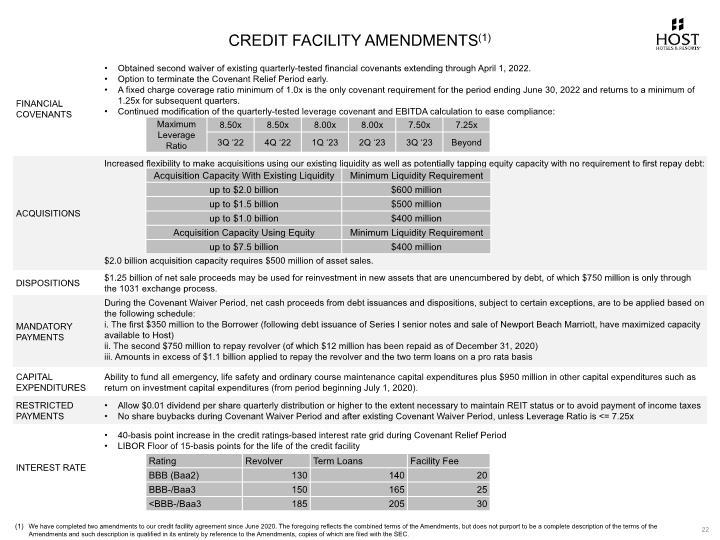
Credit Facility Amendments(1) 22 We have completed two amendments to our credit facility agreement since June 2020. The foregoing reflects the combined terms of the Amendments, but does not purport to be a complete description of the terms of the Amendments and such description is qualified in its entirety by reference to the Amendments, copies of which are filed with the SEC.

financial Covenants: Credit Facility and Senior Notes Financial Performance Tests 23 (unaudited, in millions, except ratios) The following tables present the financial performance tests for our credit facility and senior notes: Covenant ratios are calculated using Host’s credit facility definitions and are for informational purposes only, as the covenants are not currently in effect under the Amendments. The GAAP ratio is not relevant for the purpose of the financial covenants. See the following pages for a reconciliation of the equivalent GAAP measure. If the leverage ratio is greater than 7.0x then the unsecured interest coverage ratio minimum becomes 1.50x. Covenant ratios are calculated using Host’s senior notes indenture definitions. The GAAP ratio is not relevant for the purpose of the financial covenants. See the following pages for a reconciliation of the equivalent GAAP measure. As of December 31, 2020, the Company was below the financial covenant levels under its senior notes indentures necessary to incur debt, and, as a result, it will not be able to incur additional debt while below these levels.

Financial covenants: Reconciliation of GAAP Leverage Ratio to Credit Facility Leverage Ratio 24 (unaudited, in millions, except ratios) The following table presents the calculation of our leverage ratio as used in the financial covenants of the credit facility: The following presents the reconciliation of debt to net debt per our credit facility definition: (2) The following presents the reconciliation of net loss to EBITDA, EBITDAre, Adjusted EBITDAre and Adjusted EBITDA per our credit facility definition in determining leverage ratio: The following tables present the calculation of our leverage ratio using GAAP measures and used in the financial covenants of the credit facility:
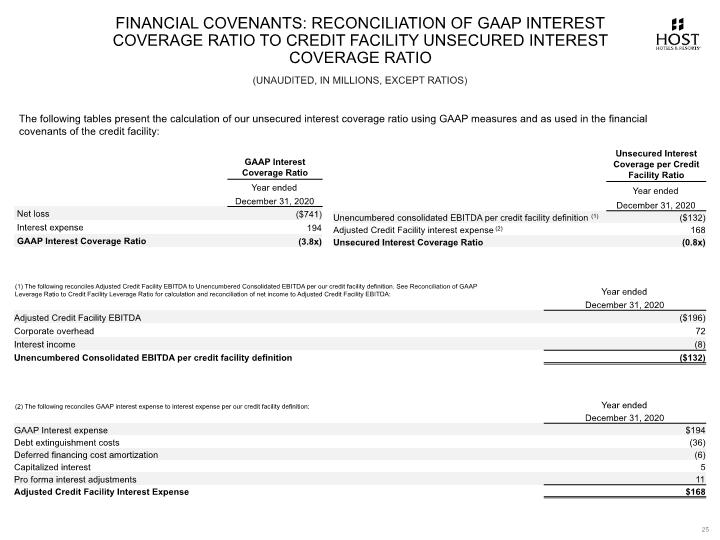
Financial Covenants: Reconciliation of GAAP Interest Coverage Ratio to Credit Facility Unsecured Interest Coverage Ratio 25 (unaudited, in millions, except ratios) The following tables present the calculation of our unsecured interest coverage ratio using GAAP measures and as used in the financial covenants of the credit facility: (1) The following reconciles Adjusted Credit Facility EBITDA to Unencumbered Consolidated EBITDA per our credit facility definition. See Reconciliation of GAAP Leverage Ratio to Credit Facility Leverage Ratio for calculation and reconciliation of net income to Adjusted Credit Facility EBITDA: (2) The following reconciles GAAP interest expense to interest expense per our credit facility definition:
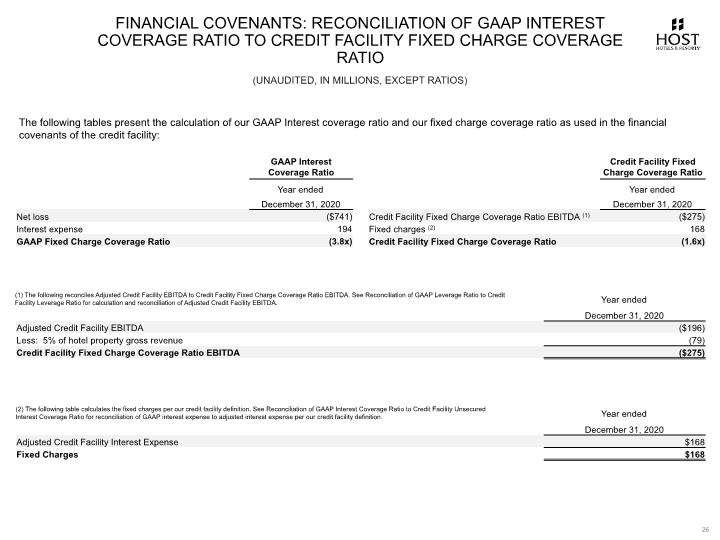
Financial Covenants: Reconciliation of GAAP Interest Coverage Ratio to Credit Facility Fixed Charge Coverage Ratio 26 (unaudited, in millions, except ratios) The following tables present the calculation of our GAAP Interest coverage ratio and our fixed charge coverage ratio as used in the financial covenants of the credit facility: (2) The following table calculates the fixed charges per our credit facility definition. See Reconciliation of GAAP Interest Coverage Ratio to Credit Facility Unsecured Interest Coverage Ratio for reconciliation of GAAP interest expense to adjusted interest expense per our credit facility definition. (1) The following reconciles Adjusted Credit Facility EBITDA to Credit Facility Fixed Charge Coverage Ratio EBITDA. See Reconciliation of GAAP Leverage Ratio to Credit Facility Leverage Ratio for calculation and reconciliation of Adjusted Credit Facility EBITDA.
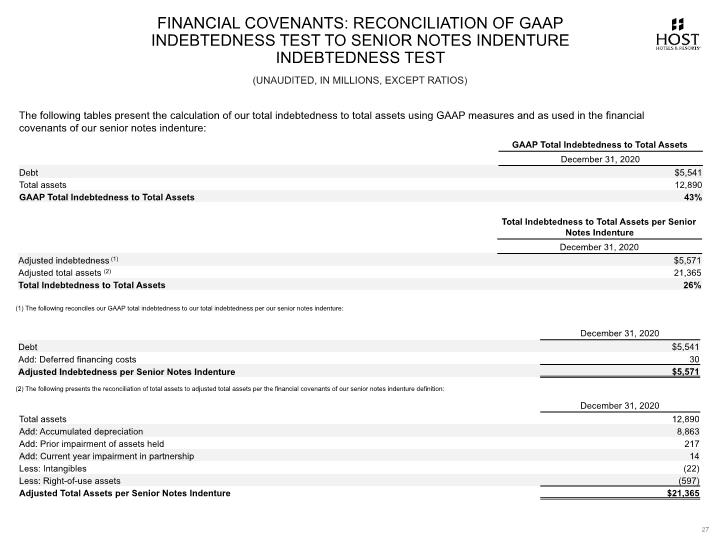
Financial Covenants: Reconciliation of GAAP Indebtedness Test to Senior Notes Indenture Indebtedness Test 27 (unaudited, in millions, except ratios) The following tables present the calculation of our total indebtedness to total assets using GAAP measures and as used in the financial covenants of our senior notes indenture: (2) The following presents the reconciliation of total assets to adjusted total assets per the financial covenants of our senior notes indenture definition: (1) The following reconciles our GAAP total indebtedness to our total indebtedness per our senior notes indenture:
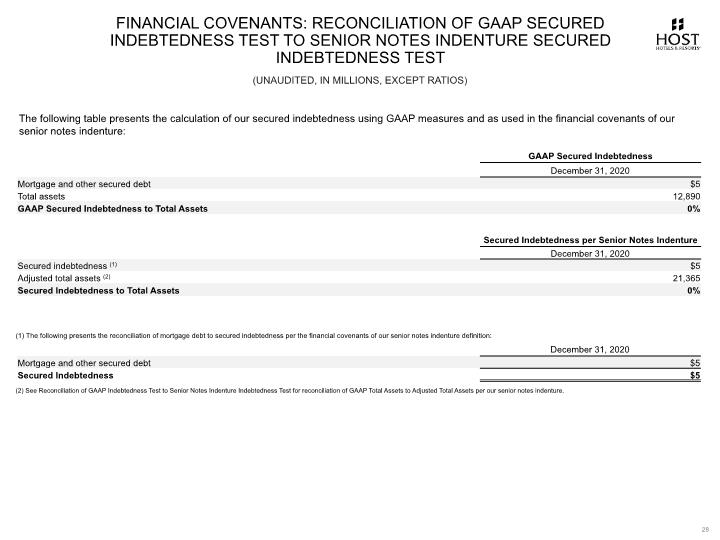
Financial Covenants: Reconciliation of GAAP Secured Indebtedness Test to Senior Notes Indenture Secured Indebtedness Test 28 (unaudited, in millions, except ratios) The following table presents the calculation of our secured indebtedness using GAAP measures and as used in the financial covenants of our senior notes indenture: (2) See Reconciliation of GAAP Indebtedness Test to Senior Notes Indenture Indebtedness Test for reconciliation of GAAP Total Assets to Adjusted Total Assets per our senior notes indenture. (1) The following presents the reconciliation of mortgage debt to secured indebtedness per the financial covenants of our senior notes indenture definition:
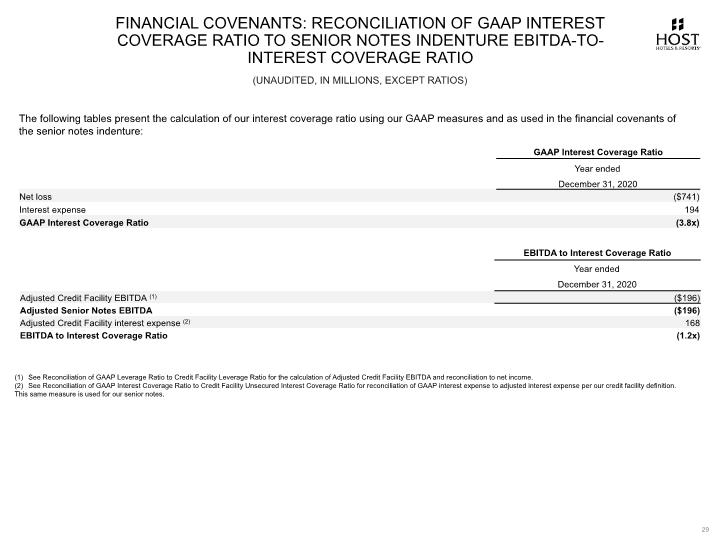
Financial Covenants: Reconciliation of GAAP Interest Coverage Ratio to Senior Notes Indenture EBITDA-to-Interest Coverage Ratio 29 (unaudited, in millions, except ratios) The following tables present the calculation of our interest coverage ratio using our GAAP measures and as used in the financial covenants of the senior notes indenture: (1) See Reconciliation of GAAP Leverage Ratio to Credit Facility Leverage Ratio for the calculation of Adjusted Credit Facility EBITDA and reconciliation to net income. (2) See Reconciliation of GAAP Interest Coverage Ratio to Credit Facility Unsecured Interest Coverage Ratio for reconciliation of GAAP interest expense to adjusted interest expense per our credit facility definition. This same measure is used for our senior notes.
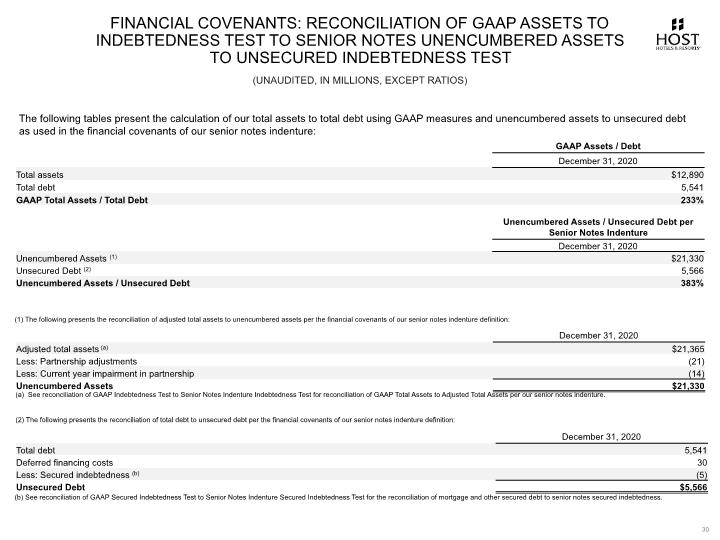
Financial Covenants: Reconciliation of GAAP Assets to Indebtedness Test to Senior Notes Unencumbered Assets to Unsecured Indebtedness Test 30 (unaudited, in millions, except ratios) The following tables present the calculation of our total assets to total debt using GAAP measures and unencumbered assets to unsecured debt as used in the financial covenants of our senior notes indenture: (1) The following presents the reconciliation of adjusted total assets to unencumbered assets per the financial covenants of our senior notes indenture definition: (a) See reconciliation of GAAP Indebtedness Test to Senior Notes Indenture Indebtedness Test for reconciliation of GAAP Total Assets to Adjusted Total Assets per our senior notes indenture. (2) The following presents the reconciliation of total debt to unsecured debt per the financial covenants of our senior notes indenture definition: (b) See reconciliation of GAAP Secured Indebtedness Test to Senior Notes Indenture Secured Indebtedness Test for the reconciliation of mortgage and other secured debt to senior notes secured indebtedness.

Hotels with Suspended Operations 31 The following table consists of hotels with suspended operations as of February 18, 2021:

Overview Property level data capitalization Covid-19 data NOTES TO SUPPLEMENTAL FINANCIAL INFORMATION 32
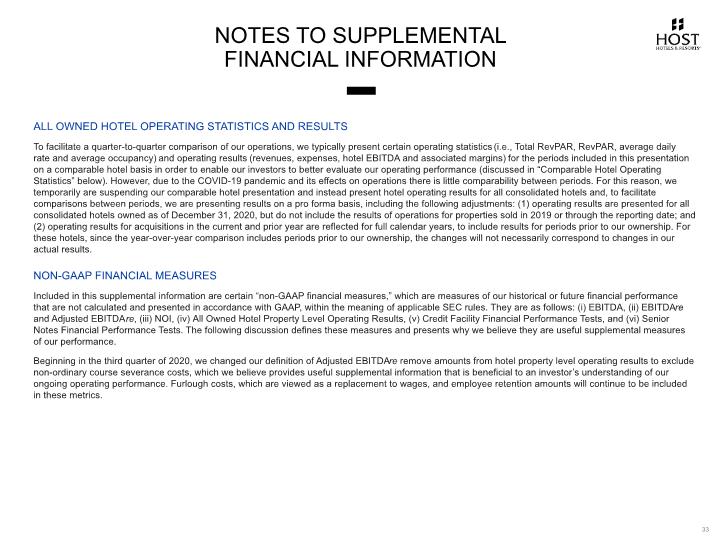
All Owned Hotel Operating Statistics and Results To facilitate a quarter-to-quarter comparison of our operations, we typically present certain operating statistics (i.e., Total RevPAR, RevPAR, average daily rate and average occupancy) and operating results (revenues, expenses, hotel EBITDA and associated margins) for the periods included in this presentation on a comparable hotel basis in order to enable our investors to better evaluate our operating performance (discussed in “Comparable Hotel Operating Statistics” below). However, due to the COVID-19 pandemic and its effects on operations there is little comparability between periods. For this reason, we temporarily are suspending our comparable hotel presentation and instead present hotel operating results for all consolidated hotels and, to facilitate comparisons between periods, we are presenting results on a pro forma basis, including the following adjustments: (1) operating results are presented for all consolidated hotels owned as of December 31, 2020, but do not include the results of operations for properties sold in 2019 or through the reporting date; and (2) operating results for acquisitions in the current and prior year are reflected for full calendar years, to include results for periods prior to our ownership. For these hotels, since the year-over-year comparison includes periods prior to our ownership, the changes will not necessarily correspond to changes in our actual results. Non-GAAP financial measures Included in this supplemental information are certain “non-GAAP financial measures,” which are measures of our historical or future financial performance that are not calculated and presented in accordance with GAAP, within the meaning of applicable SEC rules. They are as follows: (i) EBITDA, (ii) EBITDAre and Adjusted EBITDAre, (iii) NOI, (iv) All Owned Hotel Property Level Operating Results, (v) Credit Facility Financial Performance Tests, and (vi) Senior Notes Financial Performance Tests. The following discussion defines these measures and presents why we believe they are useful supplemental measures of our performance. Beginning in the third quarter of 2020, we changed our definition of Adjusted EBITDAre remove amounts from hotel property level operating results to exclude non-ordinary course severance costs, which we believe provides useful supplemental information that is beneficial to an investor’s understanding of our ongoing operating performance. Furlough costs, which are viewed as a replacement to wages, and employee retention amounts will continue to be included in these metrics. 33 Notes to supplemental financial information

Non-GAAP financial measures (continued) EBITDA and NOI Earnings before Interest Expense, Income Taxes, Depreciation and Amortization (“EBITDA”) is a commonly used measure of performance in many industries. Management believes EBITDA provides useful information to investors regarding our results of operations because it helps us and our investors evaluate the ongoing operating performance of our properties after removing the impact of the Company’s capital structure (primarily interest expense) and its asset base (primarily depreciation and amortization). Management also believes the use of EBITDA facilitates comparisons between us and other lodging REITs, hotel owners that are not REITs and other capital-intensive companies. Management uses EBITDA to evaluate property-level results and EBITDA multiples (calculated as sales price divided by EBITDA) as one measure in determining the value of acquisitions and dispositions and, like Funds From Operations (“FFO”) and Adjusted FFO per diluted share, it is widely used by management in the annual budget process and for our compensation programs. Management also uses NOI when calculating capitalization rates (“Cap Rates”) to evaluate acquisitions and dispositions. For a specific hotel, NOI is calculated as the hotel or entity level EBITDA less an estimate for the annual contractual reserve requirements for renewal and replacement expenditures. Cap Rates are calculated as NOI divided by sales price. Management believes using Cap Rates allows for a consistent valuation method in comparing the purchase or sale value of properties. EBITDAre and Adjusted EBITDAre We present EBITDAre in accordance with NAREIT guidelines, as defined in its September 2017 white paper “Earnings Before Interest, Taxes, Depreciation and Amortization for Real Estate,” to provide an additional performance measure to facilitate the evaluation and comparison of the Company’s results with other REITs. NAREIT defines EBITDAre as net income (calculated in accordance with GAAP) excluding interest expense, income tax, depreciation and amortization, gains or losses on disposition of depreciated property (including gains or losses on change of control), impairment expense of depreciated property and of investments in unconsolidated affiliates caused by a decrease in value of depreciated property in the affiliate, and adjustments to reflect the entity’s pro rata share of EBITDAre of unconsolidated affiliates. We make additional adjustments to EBITDAre when evaluating our performance because we believe that the exclusion of certain additional items described below provides useful supplemental information to investors regarding our ongoing operating performance. We believe that the presentation of Adjusted EBITDAre, when combined with the primary GAAP presentation of net income, is beneficial to an investor’s understanding of our operating performance. Adjusted EBITDAre also is similar to the measure used to calculate certain credit ratios for our credit facility and senior notes. We adjust EBITDAre for the following items, which may occur in any period, and refer to this measure as Adjusted EBITDAre: Property Insurance Gains – We exclude the effect of property insurance gains reflected in our consolidated statements of operations because we believe that including them in Adjusted EBITDAre is not consistent with reflecting the ongoing performance of our assets. In addition, property insurance gains could be less important to investors given that the depreciated asset book value written off in connection with the calculation of the property insurance gain often does not reflect the market value of real estate assets. 34 Notes to supplemental financial information
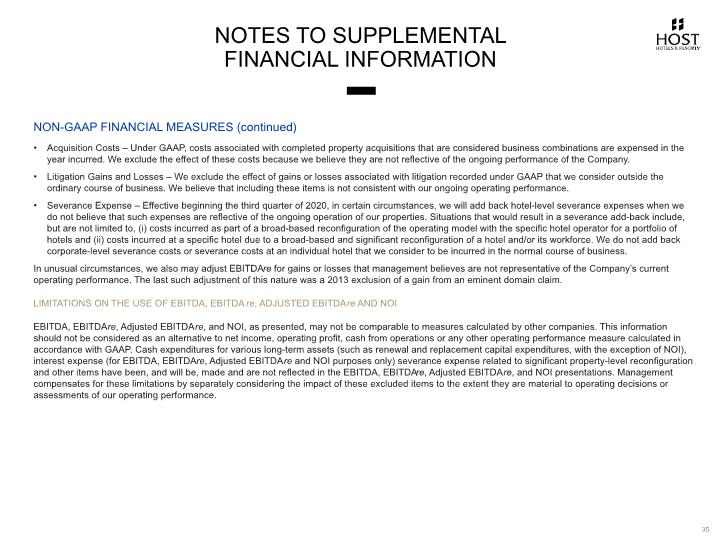
Non-GAAP financial measures (continued) Acquisition Costs – Under GAAP, costs associated with completed property acquisitions that are considered business combinations are expensed in the year incurred. We exclude the effect of these costs because we believe they are not reflective of the ongoing performance of the Company. Litigation Gains and Losses – We exclude the effect of gains or losses associated with litigation recorded under GAAP that we consider outside the ordinary course of business. We believe that including these items is not consistent with our ongoing operating performance. Severance Expense – Effective beginning the third quarter of 2020, in certain circumstances, we will add back hotel-level severance expenses when we do not believe that such expenses are reflective of the ongoing operation of our properties. Situations that would result in a severance add-back include, but are not limited to, (i) costs incurred as part of a broad-based reconfiguration of the operating model with the specific hotel operator for a portfolio of hotels and (ii) costs incurred at a specific hotel due to a broad-based and significant reconfiguration of a hotel and/or its workforce. We do not add back corporate-level severance costs or severance costs at an individual hotel that we consider to be incurred in the normal course of business. In unusual circumstances, we also may adjust EBITDAre for gains or losses that management believes are not representative of the Company’s current operating performance. The last such adjustment of this nature was a 2013 exclusion of a gain from an eminent domain claim. Limitations on the Use of EBITDA, EBITDAre, Adjusted EBITDAre and NOI EBITDA, EBITDAre, Adjusted EBITDAre, and NOI, as presented, may not be comparable to measures calculated by other companies. This information should not be considered as an alternative to net income, operating profit, cash from operations or any other operating performance measure calculated in accordance with GAAP. Cash expenditures for various long-term assets (such as renewal and replacement capital expenditures, with the exception of NOI), interest expense (for EBITDA, EBITDAre, Adjusted EBITDAre and NOI purposes only) severance expense related to significant property-level reconfiguration and other items have been, and will be, made and are not reflected in the EBITDA, EBITDAre, Adjusted EBITDAre, and NOI presentations. Management compensates for these limitations by separately considering the impact of these excluded items to the extent they are material to operating decisions or assessments of our operating performance. 35 Notes to supplemental financial information
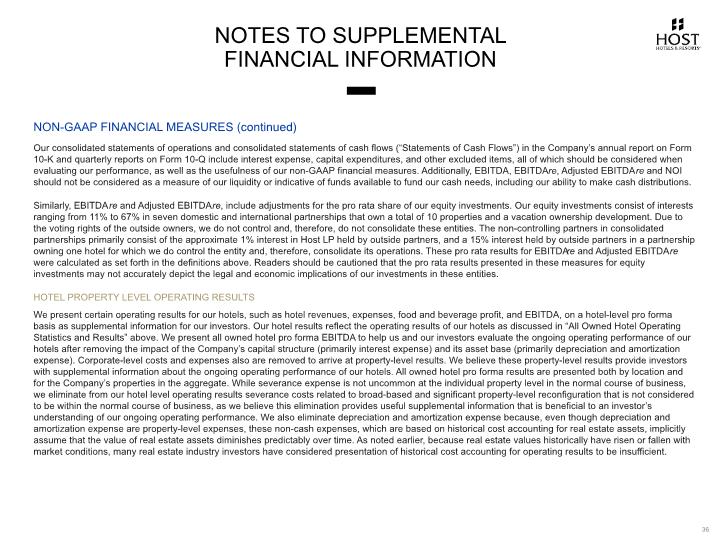
Non-GAAP financial measures (continued) Our consolidated statements of operations and consolidated statements of cash flows (“Statements of Cash Flows”) in the Company’s annual report on Form 10-K and quarterly reports on Form 10-Q include interest expense, capital expenditures, and other excluded items, all of which should be considered when evaluating our performance, as well as the usefulness of our non-GAAP financial measures. Additionally, EBITDA, EBITDAre, Adjusted EBITDAre and NOI should not be considered as a measure of our liquidity or indicative of funds available to fund our cash needs, including our ability to make cash distributions. Similarly, EBITDAre and Adjusted EBITDAre, include adjustments for the pro rata share of our equity investments. Our equity investments consist of interests ranging from 11% to 67% in seven domestic and international partnerships that own a total of 10 properties and a vacation ownership development. Due to the voting rights of the outside owners, we do not control and, therefore, do not consolidate these entities. The non-controlling partners in consolidated partnerships primarily consist of the approximate 1% interest in Host LP held by outside partners, and a 15% interest held by outside partners in a partnership owning one hotel for which we do control the entity and, therefore, consolidate its operations. These pro rata results for EBITDAre and Adjusted EBITDAre were calculated as set forth in the definitions above. Readers should be cautioned that the pro rata results presented in these measures for equity investments may not accurately depict the legal and economic implications of our investments in these entities. Hotel Property Level Operating Results We present certain operating results for our hotels, such as hotel revenues, expenses, food and beverage profit, and EBITDA, on a hotel-level pro forma basis as supplemental information for our investors. Our hotel results reflect the operating results of our hotels as discussed in “All Owned Hotel Operating Statistics and Results” above. We present all owned hotel pro forma EBITDA to help us and our investors evaluate the ongoing operating performance of our hotels after removing the impact of the Company’s capital structure (primarily interest expense) and its asset base (primarily depreciation and amortization expense). Corporate-level costs and expenses also are removed to arrive at property-level results. We believe these property-level results provide investors with supplemental information about the ongoing operating performance of our hotels. All owned hotel pro forma results are presented both by location and for the Company’s properties in the aggregate. While severance expense is not uncommon at the individual property level in the normal course of business, we eliminate from our hotel level operating results severance costs related to broad-based and significant property-level reconfiguration that is not considered to be within the normal course of business, as we believe this elimination provides useful supplemental information that is beneficial to an investor’s understanding of our ongoing operating performance. We also eliminate depreciation and amortization expense because, even though depreciation and amortization expense are property-level expenses, these non-cash expenses, which are based on historical cost accounting for real estate assets, implicitly assume that the value of real estate assets diminishes predictably over time. As noted earlier, because real estate values historically have risen or fallen with market conditions, many real estate industry investors have considered presentation of historical cost accounting for operating results to be insufficient. 36 Notes to supplemental financial information
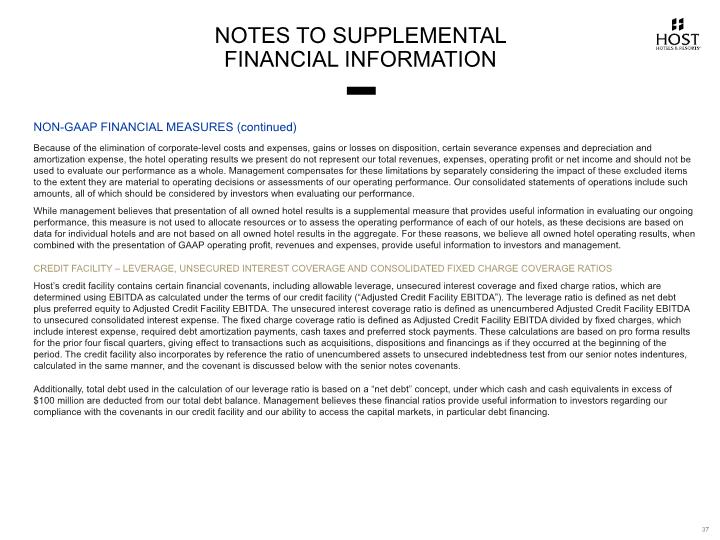
Non-GAAP financial measures (continued) Because of the elimination of corporate-level costs and expenses, gains or losses on disposition, certain severance expenses and depreciation and amortization expense, the hotel operating results we present do not represent our total revenues, expenses, operating profit or net income and should not be used to evaluate our performance as a whole. Management compensates for these limitations by separately considering the impact of these excluded items to the extent they are material to operating decisions or assessments of our operating performance. Our consolidated statements of operations include such amounts, all of which should be considered by investors when evaluating our performance. While management believes that presentation of all owned hotel results is a supplemental measure that provides useful information in evaluating our ongoing performance, this measure is not used to allocate resources or to assess the operating performance of each of our hotels, as these decisions are based on data for individual hotels and are not based on all owned hotel results in the aggregate. For these reasons, we believe all owned hotel operating results, when combined with the presentation of GAAP operating profit, revenues and expenses, provide useful information to investors and management. Credit Facility – Leverage, Unsecured Interest Coverage and Consolidated Fixed Charge Coverage Ratios Host’s credit facility contains certain financial covenants, including allowable leverage, unsecured interest coverage and fixed charge ratios, which are determined using EBITDA as calculated under the terms of our credit facility (“Adjusted Credit Facility EBITDA”). The leverage ratio is defined as net debt plus preferred equity to Adjusted Credit Facility EBITDA. The unsecured interest coverage ratio is defined as unencumbered Adjusted Credit Facility EBITDA to unsecured consolidated interest expense. The fixed charge coverage ratio is defined as Adjusted Credit Facility EBITDA divided by fixed charges, which include interest expense, required debt amortization payments, cash taxes and preferred stock payments. These calculations are based on pro forma results for the prior four fiscal quarters, giving effect to transactions such as acquisitions, dispositions and financings as if they occurred at the beginning of the period. The credit facility also incorporates by reference the ratio of unencumbered assets to unsecured indebtedness test from our senior notes indentures, calculated in the same manner, and the covenant is discussed below with the senior notes covenants. Additionally, total debt used in the calculation of our leverage ratio is based on a “net debt” concept, under which cash and cash equivalents in excess of $100 million are deducted from our total debt balance. Management believes these financial ratios provide useful information to investors regarding our compliance with the covenants in our credit facility and our ability to access the capital markets, in particular debt financing. 37 Notes to supplemental financial information
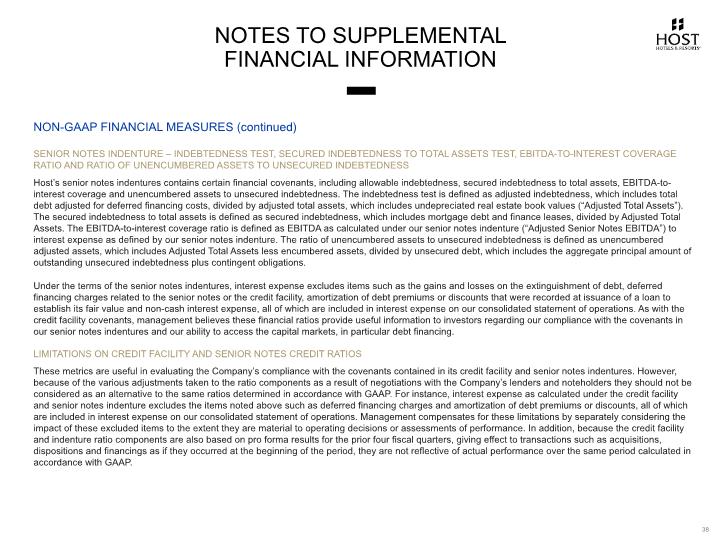
Non-GAAP financial measures (continued) Senior Notes Indenture – Indebtedness Test, Secured Indebtedness to Total Assets Test, EBITDA-to-Interest Coverage Ratio and Ratio of Unencumbered Assets to Unsecured Indebtedness Host’s senior notes indentures contains certain financial covenants, including allowable indebtedness, secured indebtedness to total assets, EBITDA-to-interest coverage and unencumbered assets to unsecured indebtedness. The indebtedness test is defined as adjusted indebtedness, which includes total debt adjusted for deferred financing costs, divided by adjusted total assets, which includes undepreciated real estate book values (“Adjusted Total Assets”). The secured indebtedness to total assets is defined as secured indebtedness, which includes mortgage debt and finance leases, divided by Adjusted Total Assets. The EBITDA-to-interest coverage ratio is defined as EBITDA as calculated under our senior notes indenture (“Adjusted Senior Notes EBITDA”) to interest expense as defined by our senior notes indenture. The ratio of unencumbered assets to unsecured indebtedness is defined as unencumbered adjusted assets, which includes Adjusted Total Assets less encumbered assets, divided by unsecured debt, which includes the aggregate principal amount of outstanding unsecured indebtedness plus contingent obligations. Under the terms of the senior notes indentures, interest expense excludes items such as the gains and losses on the extinguishment of debt, deferred financing charges related to the senior notes or the credit facility, amortization of debt premiums or discounts that were recorded at issuance of a loan to establish its fair value and non-cash interest expense, all of which are included in interest expense on our consolidated statement of operations. As with the credit facility covenants, management believes these financial ratios provide useful information to investors regarding our compliance with the covenants in our senior notes indentures and our ability to access the capital markets, in particular debt financing. Limitations on Credit Facility and Senior Notes Credit Ratios These metrics are useful in evaluating the Company’s compliance with the covenants contained in its credit facility and senior notes indentures. However, because of the various adjustments taken to the ratio components as a result of negotiations with the Company’s lenders and noteholders they should not be considered as an alternative to the same ratios determined in accordance with GAAP. For instance, interest expense as calculated under the credit facility and senior notes indenture excludes the items noted above such as deferred financing charges and amortization of debt premiums or discounts, all of which are included in interest expense on our consolidated statement of operations. Management compensates for these limitations by separately considering the impact of these excluded items to the extent they are material to operating decisions or assessments of performance. In addition, because the credit facility and indenture ratio components are also based on pro forma results for the prior four fiscal quarters, giving effect to transactions such as acquisitions, dispositions and financings as if they occurred at the beginning of the period, they are not reflective of actual performance over the same period calculated in accordance with GAAP. 38 Notes to supplemental financial information
